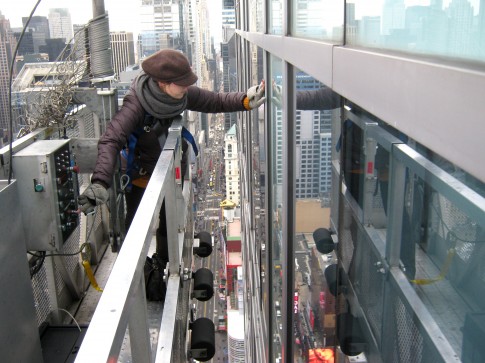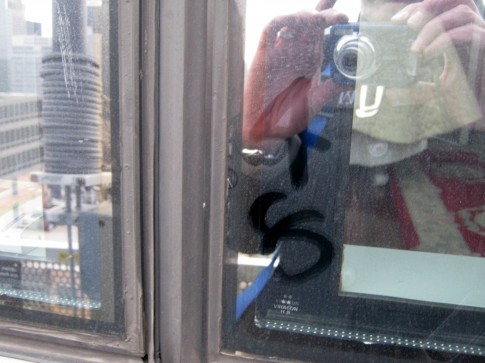
Don't look down? Too late—the 60-story void beckons.
Every architect remembers their first scaffold drop. I’ll remember mine for years to come.
As luck would have it, my first voyage was not a warm-up on, say, a 10- or 15-story building, where I could get accustomed to carefully moving around in a four-foot-wide, 25-foot-long metal basket at a modest height. Instead, my first vertical drop was down an impressive 60-story metal-and-glass tower overlooking Times Square for the building’s 7th Cycle Local Law 11/98 inspection (now called the Facade Inspection & Safety Program, or FISP) earlier this year.
Fear was far from my mind when the project was first assigned to me. I was excited for the adventure—and the street cred. Here I was, having never been on a scaffold drop, and in one fell swoop I would be doing one of the highest in RAND’s history, priming myself for any measly 30-story drops in my future.

Hands on: Like a seasoned pro, Maria inspects the facade with one hand while operating the scaffold with the other.
Of course, when doomsday finally arrived, I was singing a different tune. It was a freezing January morning with winter winds whipping about when I climbed into the scaffold on the roof of the building and hooked in my safety harness. Fortunately at my side was my colleague, Ivan Mrakovcic, RA, RAND’s Survey Team Leader and scaffold drop veteran. In a typical scaffold drop, the contractor operates the scaffold, but because of the limited capacity of the rig we were using, only two people could ride the scaffold at the same time, which meant Ivan and I (after having gone through the requisite training) would be operating it ourselves.
In the scaffold, as with most challenges in life, the hardest part is that first step—or in this case push—when you don’t know for sure what’s ahead—or below. I soon found out as we lifted up and over the building’s edge, and pushed away from the stability of the bulkhead roof, which is about the same time primal fear kicked in. As the scaffold swayed more than 600 feet above the ground, my gut quickly reminded me just how far a fall it would be.
Only when the scaffold stopped moving and I braced myself with my hand against the building did my fears subside. I was then able to focus on our task at hand—inspecting the facade. Ivan and I operated the scaffold all the way down to the ground and back up, methodically checking for cracks, loose elements, or other potentially unsafe conditions. Of course, given our vantage point, we had to take an occasional break to pose for some impressive photos!
Because FISP reports must document the precise locations of found conditions, and this building’s curtain wall system looks so similar throughout its 60-story tower frame, one of the trickiest parts of this inspection was keeping track of which floor we were examining. Luckily Ivan and I had the most advanced technology at our fingertips: Literally, our fingertips, with which we marked each floor number on the dusty windows.

Dust in the wind(dow): Marking the floor number, high-tech style.
My first scaffold drop would have been a lot scarier had it not been for the guidance of my fearless leader. A seasoned pro, Ivan answered my endless stream of questions—Is my safety harness strapped too tight? Is the scaffold motor supposed to be making that funny noise? Is this the right way to fasten the tie back?—and reassured me we would make it back to the roof, safe and sound. Which I’m happy to report we did.

Maria's RAND coworker and scaffold veteran Ivan Mrakovcic talked her down (and back up) on her first scaffold drop.
I imagine most New Yorkers think of very different things when they gaze up at the city’s vast number of high-rise buildings: How does something so tall stay standing? What does the top floor cost per square foot? Who lives or works up there? But my thoughts are with the brave souls who slink up and down the side of those buildings in a metal basket.
Now I’m one of them.

One Response to Drop in the Basket